Budapest
Ethan, a Canadian roommate in Prague, arrived from
Budapest. While crossing the
Slovakian border, e was pulled off the train and told to sign a document that he
couldn’t read. When he refused,
they tossed him in a basement jail, naked, with rats, for ten hours in the dark.
The next morning they let him go. Even
though this is the kind of adventure that happens to Ethan on a regular basis, I
decided that with no one to call the embassy should the same fate befall me,
that I should instead route through Vienna to Budapest to avoid the Slovakian
crossing, though it meant I had to cross town to change stations.
My train arrived in Prague late, and my once comfortable cushion for
transfer became a rush. Navigating
in new cities is hard enough but even harder in a foreign language--plus I had
no Austrian schillings with which to buy a ticket.
Luckily my German was just good enough to ask if I was at the right tram.
I snuck into the car, hoping that in a pinch my rail ticket would cover
me or at least give me a plausible excuse.
If I had spent any longer or taken another exit from the station I would
have missed the train to Budapest, since I arrive with only a minute to spare.
I anticipated the worst in Hungary.
Turns out I had confused Budapest with some tales of Bucharest where
gypsies have been known to surround travelers in the street and rob them.
Budapest was a much different place from what I imagined.
Hungary has shared much of its history with Austria and
Bohemia (Czech)—this area having been the seat of the Hapsburgs.
The Turks gained control of Hungary for 150 years but eventually left,
though not before decorating the interior of the cathedral with ornate
mosque-like designs. When the
Christians regained control, they left the cathedral this way, making for a very
unique church.
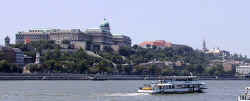 Budapest is the fusion of Buda and Pest, originally two
cities divided by the Danube river. I
arrived in Pest at the main train station and took a bus across the river to the
Backpackers Guesthouse in a Buda. What
it lacks in location, the Guesthouse more than makes up for with atmosphere.
Budapest is the fusion of Buda and Pest, originally two
cities divided by the Danube river. I
arrived in Pest at the main train station and took a bus across the river to the
Backpackers Guesthouse in a Buda. What
it lacks in location, the Guesthouse more than makes up for with atmosphere.
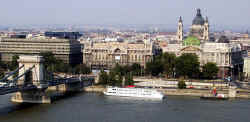 Basically a suburban house, every room has its own motif, and the outside
has a colorful paint job. I spent a
good part of my five days lounging in hammocks in the backyard or sitting in the
shade with Aussies. This was often
the best way to beat the heat, which broke 40 degrees C during the heat wave.
Basically a suburban house, every room has its own motif, and the outside
has a colorful paint job. I spent a
good part of my five days lounging in hammocks in the backyard or sitting in the
shade with Aussies. This was often
the best way to beat the heat, which broke 40 degrees C during the heat wave.
I arrived during a 30th birthday party for Barry
who works there. We headed out to
an open air park by the river near the University. Having not eaten since the train, I was glad to find a snack
bar where I pointed at the meat on the grill.
(I found out later it was a traditional pork dish.
Very tasty.) Not much English is spoken here, so I did not meet many
Hungarians and hung out almost exclusively with other backpackers here.
My first day started at a flea market in Pest with Kartini
from Singapore. The most striking
items were Nazi and Soviet war medals and paraphernalia. Afterwards we walked through the park to see a castle-like
building and then on to Heroes Square, after which we parted ways, and I ran
into Kevin, Pat, and Karen, Canadians I had met in Prague.
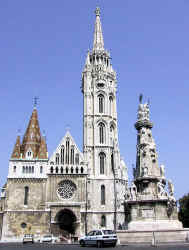 Back in Buda we climbed the hill to the castle district, where we visited
the aforementioned gothic-mosque-cathedral. Underground in this part of town are many natural caves, to which people
had long ago attached their basements, creating an underground network, used at
times as a shelter and for organized resistance during the World War II.
Today this has been turned into something called the Labyrinth. Since it sounded interesting, we wandered in—in to a
tourist trap. The best I can say
about it is that it was underground, and therefore provided an escape from the
oppressive heat outside. Basically
it is a gigantic winding basement with “art” has been added to evoke
Hungary’s history beginning with nomadic hunters and “cave paintings.” This culminates with “fossils” of computers and cell
phones in some apocalyptic statement. Most bizarre are the cell like rooms where
at night you experience your own personal labyrinth of self-reflection.
Suffice it to say that if you have some time to kill in Budapest, spend
it somewhere else.
Back in Buda we climbed the hill to the castle district, where we visited
the aforementioned gothic-mosque-cathedral. Underground in this part of town are many natural caves, to which people
had long ago attached their basements, creating an underground network, used at
times as a shelter and for organized resistance during the World War II.
Today this has been turned into something called the Labyrinth. Since it sounded interesting, we wandered in—in to a
tourist trap. The best I can say
about it is that it was underground, and therefore provided an escape from the
oppressive heat outside. Basically
it is a gigantic winding basement with “art” has been added to evoke
Hungary’s history beginning with nomadic hunters and “cave paintings.” This culminates with “fossils” of computers and cell
phones in some apocalyptic statement. Most bizarre are the cell like rooms where
at night you experience your own personal labyrinth of self-reflection.
Suffice it to say that if you have some time to kill in Budapest, spend
it somewhere else.
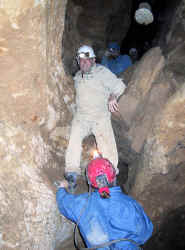 Much more interesting was a spelunking excursion.
While Hungary does not have interesting topography above ground, it has
plenty below. Hot water carved
caves in the clay, and nine of us from the hostel spent the afternoon with a
guide. We squirmed through
formations called “the birth canal” and “the sandwich of death.”
Nick (in the picture, “watch your head boys”) used me as purchase
(read foot leverage) to escape the death sandwich.
In all we traveled about a kilometer in three hours.
Much more interesting was a spelunking excursion.
While Hungary does not have interesting topography above ground, it has
plenty below. Hot water carved
caves in the clay, and nine of us from the hostel spent the afternoon with a
guide. We squirmed through
formations called “the birth canal” and “the sandwich of death.”
Nick (in the picture, “watch your head boys”) used me as purchase
(read foot leverage) to escape the death sandwich.
In all we traveled about a kilometer in three hours.
After such exertion, I needed some relaxation, so the next
day I headed to the Turkish baths. I
chose Rudas, built in 1565 and known for its architecture.
It is a traditional men’s bath. Upon
entrance, you receive a bona fide loincloth, engineered to cover only your most
private part. After sweating in
progressively hotter saunas, I went to the sulfuric pools to soak with fifty
other men. Above the large center
octagon pool is a dome which lets natural light in through colored glass.
Around the center pool are four smaller, with more extreme temperatures
from sauna to brisk. Thoroughly waterlogged, I headed for a Turkish massage.
I have always though of massage as somewhat intimate, so I have never had
a professional one. I was not sure how comfortable I would be with a large
Hungarian man rubbing me down, but it turned out relaxing in the end.
The next day Nick, Neil, and I decided to see a park that
an entrepreneur created with the 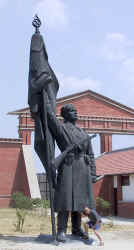 statues that the Soviets left behind when the
eastern block fell and they left Hungary. Assuming
it to be obvious, we headed off in the direction the park was in--further
outside of town. We knew to catch a
bus but discovered that which bus was the trick.
We also discovered that none of us knew the real name of the park, only
“Statue Park.” Statue is not
the first work you learn in English classes in Hungary.
Swallowing our pride, we began to pantomime statues, posing like Greek
Olympians. “Ahhh, Sobor Park,” was the dawning recognition
and key to finding the right bus after having this man explain to the woman
behind the window at the bus station where we wanted to go and then his
translating her answer for us. The
bus stop for Sobor Park was easily recognizable.
As we approached the ticket counter, the woman behind it turned on
patriotic Soviet music for us. When
we were around the corner she turned it off again.
The park itself was an interesting mix of art and propaganda.
We found it amusingly ironic that this capitalistic venture featured
communist relics. Still the most memorable bit was the three of us posing like
statues.
statues that the Soviets left behind when the
eastern block fell and they left Hungary. Assuming
it to be obvious, we headed off in the direction the park was in--further
outside of town. We knew to catch a
bus but discovered that which bus was the trick.
We also discovered that none of us knew the real name of the park, only
“Statue Park.” Statue is not
the first work you learn in English classes in Hungary.
Swallowing our pride, we began to pantomime statues, posing like Greek
Olympians. “Ahhh, Sobor Park,” was the dawning recognition
and key to finding the right bus after having this man explain to the woman
behind the window at the bus station where we wanted to go and then his
translating her answer for us. The
bus stop for Sobor Park was easily recognizable.
As we approached the ticket counter, the woman behind it turned on
patriotic Soviet music for us. When
we were around the corner she turned it off again.
The park itself was an interesting mix of art and propaganda.
We found it amusingly ironic that this capitalistic venture featured
communist relics. Still the most memorable bit was the three of us posing like
statues.
Though I had but one day before I earned my free
Backpacker’s Guesthouse t-shirt, I decided to push on to Vienna for a heavy
dose of culture.
Next Stop: Vienna
 Budapest is the fusion of Buda and Pest, originally two
cities divided by the Danube river. I
arrived in Pest at the main train station and took a bus across the river to the
Backpackers Guesthouse in a Buda. What
it lacks in location, the Guesthouse more than makes up for with atmosphere.
Budapest is the fusion of Buda and Pest, originally two
cities divided by the Danube river. I
arrived in Pest at the main train station and took a bus across the river to the
Backpackers Guesthouse in a Buda. What
it lacks in location, the Guesthouse more than makes up for with atmosphere.
 Basically a suburban house, every room has its own motif, and the outside
has a colorful paint job. I spent a
good part of my five days lounging in hammocks in the backyard or sitting in the
shade with Aussies. This was often
the best way to beat the heat, which broke 40 degrees C during the heat wave.
Basically a suburban house, every room has its own motif, and the outside
has a colorful paint job. I spent a
good part of my five days lounging in hammocks in the backyard or sitting in the
shade with Aussies. This was often
the best way to beat the heat, which broke 40 degrees C during the heat wave. 

